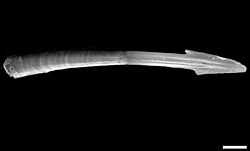Monachoides vicinus
| Monachoides vicinus | |
|---|---|
| Conservation status | |
| Scientific classification | |
| Kingdom: | Animalia |
| Phylum: | Mollusca |
| Class: | Gastropoda |
| (unranked): | clade Heterobranchia clade Euthyneura clade Panpulmonata clade Eupulmonata clade Stylommatophora informal group Sigmurethra |
| Superfamily: | Helicoidea |
| Family: | Hygromiidae |
| Genus: | Monachoides |
| Species: | M. vicinus |
| Binomial name | |
| Monachoides vicinus (O. F. Müller, 1774)[2] | |
| Synonyms | |
|
Perforatella vicina Rossmässler, 1842 | |
Monachoides vicinus (syn. Perforatella vicina) is a species of air-breathing land snail, a terrestrial pulmonate gastropod mollusk in the family Hygromiidae, the hairy snails and their allies.
Description
This is a silvicol species with a preference for deciduous and pine forests of higher altitude (over 700 m asl.),[3] where it lives on the ground among leaf-litter, or decaying dead wood.
These snails use love darts as part of their mating behavior.
Distribution
This snail is found in the Czech Republic, Poland, Slovakia, Ukraine[4] and other countries.
There are isolated occurrences in the Pannonian Plane (Bátorliget, Hungary) and in the Nordfrankischer Jura (Pottenstein).There are several published and unpublished distribution records and there is no evidence that the area of occupancy (AOO), extent of occurrence (EOO), or the number of locations are declining or extremely fluctuating.
Conservation
This species is protected in Hungary and some subpopulations are known to occur within protected areas. Although it inhabits a large area (300,000 km2), due to its special habitat preference, the population is fragmented. The species' range is not satisfactorily explored and there are no data on population trend. However, forest habitats are known to be diminishing in that region and therefore one might suppose that number of subpopulations or the number of mature individuals are declining.[5]
References
- ↑ Feher, Z. 2013. Monachoides vicinus. In: IUCN 2014. The IUCN Red List of Threatened Species. Version 2014.3. Downloaded on 20 December 2014.
- ↑ Müller O. F. 1774. Vermivm terrestrium et fluviatilium, seu animalium infusoriorum, helminthicorum, et testaceorum, non marinorum, succincta historia. Volumen alterum. pp. I-XXVI [= 1-36], 1-214, [1-10]. Havniae & Lipsiae. (Heineck & Faber).
- ↑ Grossu, A.V. 1983. Gastropoda Romaniae 4. Editura Litera, Bucuresti.
- ↑ Balashov I. & Gural-Sverlova N. 2012. An annotated checklist of the terrestrial molluscs of Ukraine. Journal of Conchology. 41 (1): 91-109.
- ↑ Feher, Z. 2013. Monachoides vicinus. The IUCN Red List of Threatened Species. Version 2014.3. Downloaded on 20 December 2014
| Wikimedia Commons has media related to Monachoides vicinus. |

